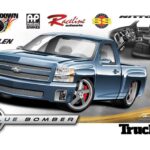A confused as Blue Oval and Mopar fanatics may be in their misguided hot rodding proclivities, at least they know a good automatic transmission when they see one. How else can you explain the overwhelming number of Outlaw 10.5 Mustangs running Powerglides and mega-buck Pro Touring Mopars equipped with 4L60 overdrives? While GM has continually set the gold standard for swap-worthy powerplants-whether they’re Rat motors, 350 Chevys, or LS small-blocks-they engineers in the transmission department have never played second-fiddle to the guys in the engine shop. As a testament to the inherent brilliance of their original designs, the Powerglide and TH400 have been staples of on-track competitors for 60 and 50 years, respectively. Likewise, the 700-R4/4L60E has already been in production for nearly 30 years, and it gets better with each of GM’s successive iterations.
Advances in modern friction discs, clutch plates, and lightweight shafts and internals have enabled building transmissions that are more durable and efficient than ever. Furthermore, the recent introduction of GM and aftermarket six-speed automatics means that there are more options available than ever for enthusiasts. With the grueling pace of transmission development, we felt it prudent to sit down with an industry expert to get the latest scoop on current R&D trends, Zack Farah of Gearstar.
CLUTCH PACKS
“High-quality friction and steels play a large role in the performance of a heavy-duty transmission. Stock applications use paper friction materials and plain steels intended for smooth shifts in daily-driver applications, such as grandpa’s ’87 Caprice. The most popular brands of performance friction materials are Raybestos’ Racing Red and Alto’s Red Eagle friction. For high-performance applications, they afford a greater coefficient of frictions between the steel plates and clutch plates. When paired up with Kolene-treated steels, this clutch pack configuration creates the greatest torque capacity per square inch of clutch surface area. In performance street/strip applications with moderate horsepower, we employ the Raybestos Red frictions with Kolene steels manufactured to standard thicknesses. In full-race applications, we use Raybestos/Kolene expanded capacity clutch packs. These are manufactured to a thinner dimension, both the steels and friction plates, so we can fit extra clutches and steels to increase total clutch surface apply area.”
COOLING
“Heat is arguably the biggest detriment to transmission longevity. Excessive heat in transmissions is detrimental for the same reason as in an engine. Would you hang your engine’s radiator off the bottom side framerail of your car? Of course not. With proper cooling, a performance transmission should live for the long haul. Automatic transmission fluid serves many functions in a transmission. It’s a hydraulic medium to transmit pressure, sometimes reaching in excess of 250 psi, to apply the clutch packs. Another one of its functions is to transfer torque and horsepower through the torque converter, and this is where 90 percent of heat is generated in the transmission. This is also hwy ample cooling and airflow over the cooler is necessary. The torque converter is in a constant bleed-and-feed mode. It’s constantly recharging with sump fluid and is building heat in the converter. The fluid is then pushed out to the cooler and return to the transmission, where it charges the lubrication circuit. This return fluid must lubricate all bearings, bushings, thrust washers, planetary gearstets, clutch packs, lip seals, sealing rings, and the valvebody assembly. After all this fluid has returned to the sump, it goes back to the torque converter and must still be cool enough to allow the converter to transmit torque, and then the cycle repeats. We recommend and insist that a 20,000 GVW Hayden cooler is installed with any transmission up to 400 horsepower, and a 30,000 GVW unit is required for any application above 400 horsepower. We also recommend eliminating any coolers that are integrated into the radiator core, as these are notorious for failure.”
STALL SPEED
“When it comes to torque converter stall speed, many people miss the mark because proper stall peed is dependent on a wide variety of factors. Based on our experience, the stall speed should generally be set a 300 rpm above the point where the cam lets the engine begin producing its toque curve. This is a good rule of thumb for street performance and driveability. For dragstrip-only use, many more factors must be considered such as body type, class rules, vehicle race weight, tire width and diameter, rear gear ratio, cubic inch displacement, stroke length, compression ratio, carb and manifold type, and all cam specs.”
TRANSBRAKES
“Races know that transbrakes help cars launch very hard, but they also help the chassis work more effectively compared to just foot-braking a car at the line. Transbrakes, when engaged, apply two different reaction clutches at the same time, which puts the trans in a bind. This way, the engine is held back and able to be brought up into its powerband without twisting the chassis. The result is a straighter, more controlled launch when the transbrake is released. Additional stress on the trans is irrelevant, as the cleaner launch is the objective. Transbrake packages are available from several sources, and there are several different engineering methods used to achieve the same result. Installing a transbrake requires many internal modifications, much more than a simple shift kit.”
SIX-SPEEDS
“Many muscle car guys are fascinated by GM’s new 6L80E trans, but its large size makes it difficult to package beneath a car and it has not had time to come of age just yet. The 700-R4/4L60E needed many years to evolve into what they can be built up to today. About 80 percent of that evolution is attributable to improvements GM made at the factory, and the other 20 percent came from the aftermarket. High-performance billet components, clutch drums, shafts, hubs, flanges, sprag clutches, and shift kits were all developed by the aftermarket. We can expect much of the same for the 6L80E. In the meantime, a 4L80 swap is a good bet for those seeking a bulletproof GM overdrive.”
AUTO BASICS
“Automatic transmissions are extremely complex devices comprised of dozens of components. In trying to explain how they work, a good place to start is the trans pump, which supplies hydraulic pressure to charge the torque converter and cooling and lubrication circuit, to apply clutch packs, band apply servos, and valvebody control systems. The input clutch drum and input shaft transmit torque from the engine and torque converter to the input element of the planetary gear system. The clutch packs provide a release mechanism for Neutral and Reverse. The direct clutch pack contains the Third gear clutch and houses the intermediate clutch sprag, providing control overt eh planetary sun gear. They determine whether it will be held for Second gear engagement, driven for Third gear, or serve as reverse input for Reverse engagement. The planetary gearsets consist of two planetary gearsets. The output planetary carrier is linked to the output shaft. The reaction planetary carrier is linked to the low-reverse clutch pack. The reaction planetary is only engaged in Low gear and Reverse, and otherwise it just goes around for the ride. The input sun gear is splined to the forward clutch pack and is applied in all forward gears. The intermediate clutch is engaged in Second gear, but is ineffective for engine braking. Hence, an intermediate brake band is applied in manual Second by a servo for engine braking in Second gear. Finally, the valvebody is basically a hydraulic computer and generates logic for shift patterns via balance valves.
DYNO TESTING
“At Gearstar, we dyno test every transmission that we build. The importance of testing each transmission is to verify operating pressures, shift points, and overall functionality. The transmission dyno is an indispensible tool for R&D since it facilitates quick removal of the pan and valvebody for recalibration of the valvebody, governor, and shift solenoids. The fluid recovery system on the dyno makes quick and easy work of dealing with 10 quarts of hot transmission fluid. Simulated loads are achieved via an 800-pound flywheel which replicates the inertia of a vehicle weighing 3,000 pounds with a 3.73:1 rear axle ratio. By running a transmission on a dyno we can check for leaks, vibrations, and abnormal noises during a simulated road test. The transmission is observed for leaks at the pump, front seal, speedo housing, rear seal, servo and accumulator housings. Shift points and shift firmness specifics for each custom-built Gearstar unit are verified on the dyno as well. Any variations in shift timing or shift quality are readily accessible for recalibration on the transmission dyno. For instance, if we experience one shift point which does not occur at the same load-speed setting as the others for that shift calibration package, it’s addressed, corrected, and verified upon retest. Transmissions which are shifted via computer or ECM, such as 4L65E and 4L85E, are tested for up to 90 minutes or 120 miles to verify that shift solenoids and pressure force motors will remain functioning properly over the long haul.”
DRAG REDUCTION
“Heavy-duty transmissions require more power to turn, but this effect can be reduced through careful parts selection. Using Torrington bearings in place of T-washers between counter-rotating components reduces parasitic drag, as does setting up clutch packs with extra clearance in First and Second gear. The low-reverse clutch pack needs extra clearance because it produces the most parasitic drag of all components in the transmission. The trade-off is a rough Reverse engagement, but that’s usually not a big deal with performance transmissions.
GM TRANS LINEUP
“The Powerglide, TH350, and TH400 each have their pros and cons in terms of price and performance in both street and race applications. The Powerglide is a two-speed design that is the ultimate in low weight, low drag, and high strength. This makes it very well suited for big-block powered drag cars. The Powerglide is the only transmission in history that can be completely built from the ground up using only heavy-duty aftermarket components, and it can easily handle 2,000 horsepower. The obvious downside is that its two speeds don’t make it very street friendly. A TH350 can be built to handle 700 horsepower, and works great in small-block applications. We usually recommend the TH400 for big-block powered street cars, as it can be built to handle 850 horsepower. For any given power level, the TH400 is cheaper to the TH350, but it also requires more power to turn.”
SHIFT FIRMNESS
“Balance in shift firmness is primarily a matter of personal preference. Smoother shifts are comfortable and produce very little shock to the drivetrain; a daily driver would benefit such an application. Firm shifts reduce clutch pack wear, but transmit great shock loads to the drivetrain, U-joints, axle splines, and body mounts. It’s all a balancing act based upon the car’s intended use, and the durability of the rest of the drivetrain.”
Ready to experience top-notch transmission solutions and expert support?

